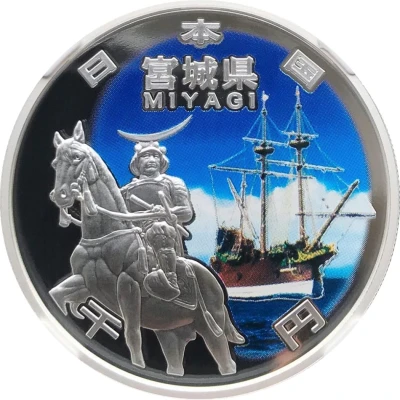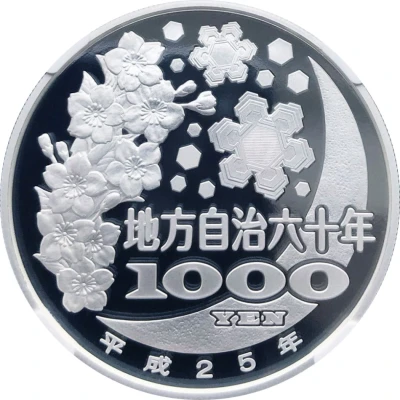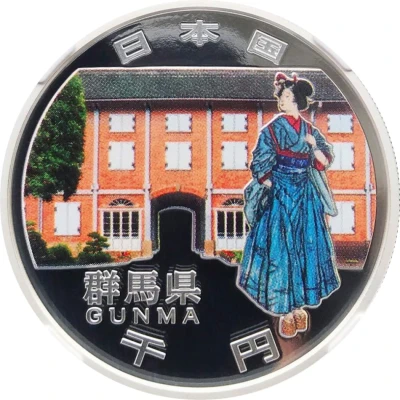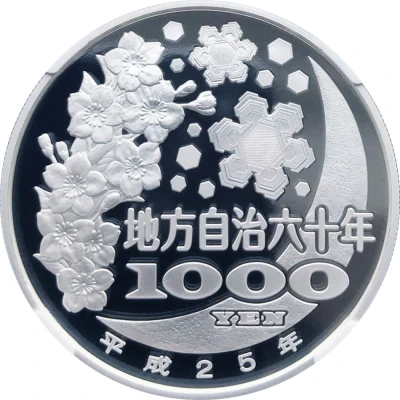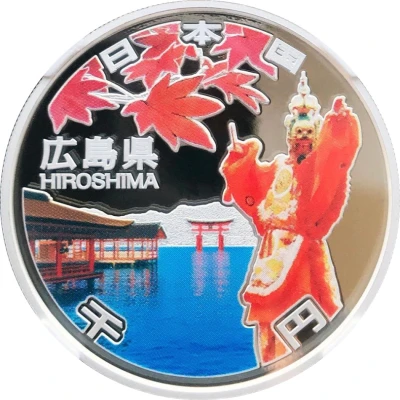
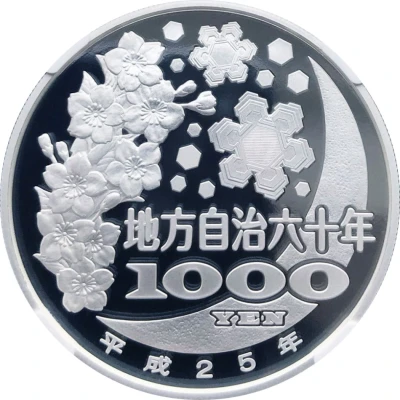

© coinsupermarket2012
1000 Yen - Heisei Hiroshima
25 (2013) year| Silver (.999) | 31.1 g | 40.0 mm |
| Issuer | Japan |
|---|---|
| Emperor | Heisei (1989-2019) |
| Type | Non-circulating coin |
| Year | 25 (2013) |
| Calendar | Japanese - Heisei era |
| Value | 1000 Yen 1000 JPY = USD 6.72 |
| Currency | Yen (1871-date) |
| Composition | Silver (.999) |
| Weight | 31.1 g |
| Diameter | 40.0 mm |
| Thickness | 3.5 mm |
| Shape | Round |
| Technique | Milled, Coloured |
| Orientation | Medal alignment ↑↑ |
| Updated | 2024-10-05 |
| Numista | N#123674 |
|---|---|
| Rarity index | 85% |
Reverse
Cherry blossoms, crescent and snowflakes.
Latent images in largest snowflake.
Lettering:
(47/60)
地方自治六十年
1000
YEN
平成25年
Translation:
60 years of local autonomy
1000
Yen
Year 25 of Heisei
Edge
Slanted reeding right
Comment
Itsukushima Shintō Shrine was founded in 593. The existing shrine pavilions were built by TAIRA no Kiyomori, a leader of samurai, in the 12th Century. The vermillion lacquered buildings and the great gate in the sea, contrasting with the green on the mountain-side, create a unique landscape. In December 1996, it was designated as the World Cultural Heritage Site.Bugaku refers to the ancient music (Gagaku) and dance, which was transmitted from India to Japan, via China and Korean Peninsula. Bugaku traditionally performed in the Itsukushima Shintō Shrine, is said to have been transmitted from Shitennōji Temple in Osaka by TAIRA no Kiyomori. Nowadays, it has been performed more than ten times a year.
Maple trees are widely distributed throughout Hiroshima Prefecture, and there are a lot of beauty spots for red maple leaves in Hiroshima, including Sandankyō Gorge, Taishaku Gorge as well as Miyajima Island, which is known as one of the three most scenic spots in Japan. This is why the maple tree has been designated as a "Tree of the Hiroshima Prefecture" since 1966.
Interesting fact
The 1000 Yen - Heisei (Hiroshima) 25 (2013) coin from Japan is part of a series of commemorative coins issued by the Japanese government to mark the 25th anniversary of the Heisei era, which began in 1989 and ended in 2019. The coin features a design that represents the theme of "peace" and "reconstruction," which is fitting given the history of Hiroshima City, where the atomic bomb was dropped in 1945. The coin's design includes an image of a phoenix rising from the ashes, symbolizing the city's resilience and determination to rebuild and thrive in the aftermath of the devastating event.
Price
| Date | Mintage | VG | F | VF | XF | AU | UNC |
|---|---|---|---|---|---|---|---|
| 25 (2013) | 100000 | - | - | - | - | - | - |
Values in the table are based on evaluations by sales realized on Internet platforms. They serve as an indication only for 1000 Yen - Heisei (Hiroshima) 25 (2013) coin.
